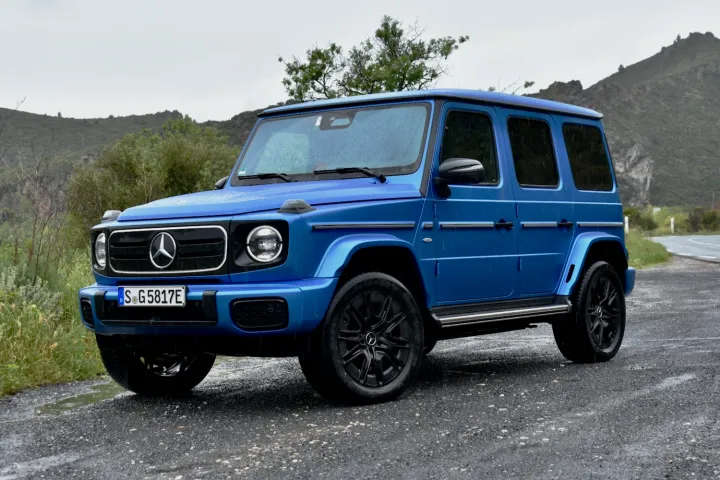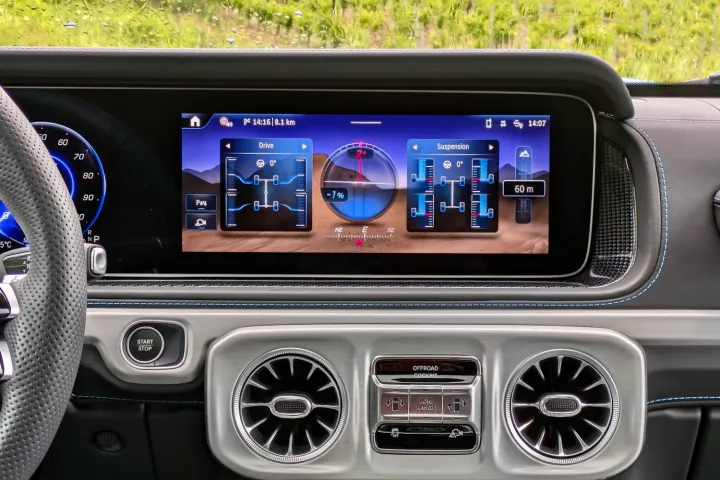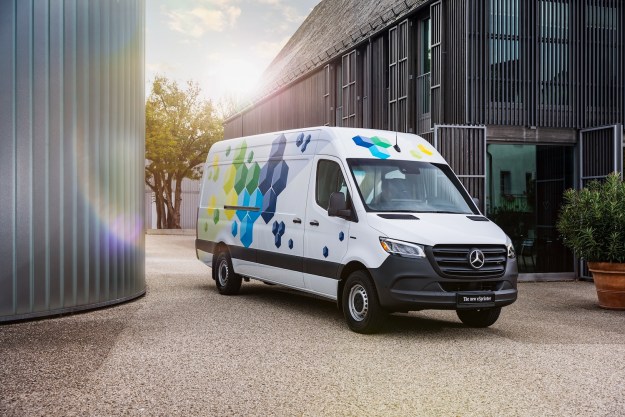
American car buyers mostly know Mercedes-Benz as a luxury brand. But for decades, the automaker has also produced the tough, rugged G-Class (also known as the Geländewagen or G-Wagen), an SUV not afraid to get its leather upholstery muddy. And now, this iconic Mercedes is going electric.
The 2025 Mercedes-Benz G580 with EQ Technology — the final name of the SUV previously known as the EQG — isn’t the first electric off-roader. The Rivian R1S and R1T and GMC Hummer EV have proven that electric powertrains and off-roading are a great combination. But the electric G-Wagen is different because it’s based on an internal-combustion model — and a very traditional one at that.
Customers expect a G-Wagen to look like a G-Wagen, so the design hasn’t changed much since the first version began traipsing along trails in 1979. Those customers are also willing to pay a premium for that look, with current gasoline G-Class models priced well into six figures. So while Mercedes hadn’t announced pricing for the electric G-Wagen at press time, don’t expect it to be a bargain.
Design

Mercedes took some styling risks with its EQS and EQE models, but it went in the opposite direction with the electric G-Class. You won’t find a dedicated EV platform here; Mercedes instead adapted EV powertrain components to fit within the G-Wagen’s old-school ladder frame. A 116-kilowatt-hour battery pack uses the same cells as Mercedes’ other electric models, for example, but they’re stacked in two layers to fit between the frame rails.
Sitting on top of the frame is a lightly modified version of the instantly recognizable body from gasoline G-Class models. Small vents on the rear fender flares, a raised hood, and a mostly blanked-off grille are the main indicators that this G-Class is powered by electricity rather than gasoline. Everything else is the same, including hefty doors that feel more appropriate for a house than a car. Mercedes prioritized aerodynamics with its other EQ models, but making sure the G580 looked like a true G-Class took precedent here. Mission accomplished.
Similarities with gasoline G-Class models carry through to the interior. A G-Class may look tough and militaristic on the outside, but on the inside it’s as luxurious as any other well-equipped Mercedes. It also has the same design aesthetic, with big round air vents, 64-color ambient lighting, and shiny metallic trim that makes for an odd contrast with the chunky dashboard grab handle and prominent dashboard buttons for the G580’s various off-road features.
Making the G580 look like a true G-Class took precedent here.
Because it uses an internal-combustion-derived platform, the G580 also has the same retro driving position as gasoline G-Class models. You sit much more upright than in most other modern SUVs, with the steering wheel placed at an angle that makes a relaxed seating position even more difficult. This also means headroom in both rows is generous, but legroom less so, while cargo space is merely adequate for a vehicle of this size. Still, the interior layout is as much a part of the G-Class experience as the styling, and the electric model doesn’t mess with it.
Tech

The G580 comes standard with a version of the Mercedes-Benz User Experience (MBUX) infotainment system used in the automaker’s other vehicles. In this case, it’s teamed with dual 12.3-inch displays, one serving as the instrument cluster and one serving as the main touchscreen. Wireless Apple CarPlay and Android Auto and a Burmester 3D surround sound system with Dolby Atmos are standard, while a dashcam and rear-seat entertainment system with dual 11.6-inch screens are optional.
The user experience is similar to other Mercedes models, with a few tweaks specific to the G-Wagen’s off-road mission. The graphics for both the touchscreen and instrument cluster show a bit more creativity than is the case with other luxury brands, and they even blend quite nicely with the physical elements of the interior. For G-Class models, Mercedes also provides an off-road screen that shows things like an inclinometer and the movement of the suspension. Like other MBUX-equipped models, excellent voice control also lessens reliance on the touchscreen and the somewhat confusing touchpad controller on the center console.
Graphics show a bit more creativity than is the case with other luxury brands.
Like many new vehicles, the G580 is equipped with a 360-degree camera system that stitches together feeds from multiple cameras to create a surround view. But it also leverages the built-in cameras for a “transparent hood” view that shows what’s directly in front of the vehicle. That comes in handy when approaching steep inclines, or for spotting rocks and other potentially tire-damaging detritus that might be hiding below the level of the windshield.
Expected driver-assist features like adaptive cruise control, automatic emergency braking, lane keep assist, blind spot monitoring, and automated lane centering are standard as well, along with park assist, a driver attention monitor, traffic sign recognition, and Pre-Safe, which is designed to help protect occupants in the event of an imminent collision. It even plays a special sound to protect against hearing loss in a crash.
Driving experience

The G580 has a quad-motor powertrain with two motors per each axle developing a combined 579 horsepower and 859 pound-feet of torque. Mercedes quotes zero to 60 mph in 4.6 seconds, while the top speed is electronically limited to 112 mph.
This is not the first quick G-Class, and it shares the same problem as its predecessors, namely that it’s still a heavy vehicle with a high center of gravity that’s designed for attacking steep slopes and mud bogs — not corners. Handling and ride quality are both retrograde, although that’s a common G-Class trait. The electric G580 wasn’t any worse to drive than the gasoline G550 that was also on hand for this first drive. And the EV’s regenerative braking — with intensity selectable through steering wheel paddles — at least lets you put its girth to work at recovering energy.
Any G-Class — gasoline or electric — is built to go off-road.
The G-Class’ tall, upright body has always made reducing noise to Mercedes-like levels a challenge for engineers, and that’s doubly true for the G580 and its silent electric powertrain. Mercedes points to some subtle changes to the classic G-Class shape — such as reshaped front roof pillars with more aerodynamic trim pieces — that help to reduce noise across the board, but the G580 also relies on an artificial soundtrack called G-Roar to mask unpleasant sounds like wind rushing around the mirrors or the reverberation of the tires. However, G-Roar isn’t particularly pleasant either. It’s in an aural uncanny valley, sounding somewhat like an engine, but not quite the same.
All of this can be excused, though, because any G-Class — gasoline or electric — is built to go off-road. Mercedes’ insistence on never changing the styling isn’t just about aesthetics. Short overhangs and a track that’s narrow enough for the G-Class to easily fit on trails, but wide enough for stability mean this SUV fears no obstacle. The G580 adds the flexible torque delivery of electric motors, allowing it to creep along at low speeds or bolt up hills without losing traction. And because there are no mechanical differentials (as in a gasoline G-Class,) you have fewer settings to keep track of. Mercedes does include low-range gearing like more traditional off-roaders, as well as a selection of drive modes.
The G580 can be driven just like a conventional G-Class as a result, but Mercedes also threw in some EV-only gimmicks. G-Turn allows the G580 to spin around in a circle on loose surfaces, similar to Rivian’s discarded Tank Turn feature. With the car in its Rock drive mode with low range selected and the brakes on, you depress the brake pedal, pull a steering wheel paddle (left or right, to determine the direction of the turn), hold the steering wheel, and hit the accelerator. The G580 will then do two complete turns automatically. Mercedes claims this is helpful for turning around in tight spaces, but the fact that we were instructed to try G-Turn in a wide open patch of dirt smacks of a serious automaker trying to rationalize an inherently silly feature.
Much more useful is G-Steering. This drags the inside rear wheel when turning (again, on loose surfaces), vastly reducing the turning radius and letting you scoot the G-Wagen around sharp corners. It’s a bit like pulling the handbrake, except it requires much less coordination. Simply press a button on the dashboard and the car does the rest. The steering itself even feels quite natural; the car just happens to be turning in tighter circles.
Range and charging

Mercedes estimates around 240 miles of range, which isn’t that impressive for such a large battery pack. The G-Class has never been a model of efficiency, though, and despite this rig’s off-road capability, most of its wealthy owners will likely never venture too far from a charging station. A front-axle disconnect may also boost real-world efficiency, and the navigation system can also incorporate charging stops into a planned route.
When it is time to recharge, 200-kilowatt DC fast charging should allow the G580 to complete a 10% to 80% charge in 32 minutes, according to Mercedes, which is well within the accepted range. For home charging, an 11.5-kilowatt AC onboard charger takes 13.5 hours to complete a full charge. Mercedes is in the process of adopting the Tesla North American Charging Standard (NACS) connector, but the G580 will launch with the current Combined Charging Standard (CCS) connector.
How DT would configure this car

Aside from personalization options like paint colors and interior trim, the G580 with EQ Technology is sold in basically one spec. It’s considered just one variant within the broader G-Class range, rather than a distinct model like the Mercedes EQE or EQS SUVs, for example.
That leaves the question of whether to buy a G580 or one of the two gasoline G-Class configurations available for 2025. Aside from the logistics of range and charging, we found the G580 to be pretty much interchangeable with the six-cylinder G550. They drove equally well on the road and were equally capable off it. Mercedes also offers a sportier AMG G63 gasoline model with a powerful V8 engine and more sophisticated suspension that did feel like a step up in capability — assuming you’re OK with burning lots of hydrocarbons.
The G580 is a noteworthy achievement simply for applying an electric powertrain to one of the most tradition-bound nameplates in the auto industry without compromise. It also splits the difference between the forward-looking Rivian R1S and the cartoonish GMC Hummer EV SUV, offering some of the latter’s swagger with a healthy dose of the former’s practicality. Like the gasoline models that came before it, the G580 stands out from other off-roaders and luxury SUVs by doing things in its own unique way.
Editors' Recommendations
- Mercedes G580 electrifies an off-road icon
- Mercedes’ electric eSprinter isn’t just greener, it’s better
- Mercedes-AMG EQE SUV first drive review: a better electric SUV
- Mercedes-Benz Vision One-Eleven concept looks to the past for inspiration
- Mercedes-Maybach EQS SUV is old-school luxury — electrified


